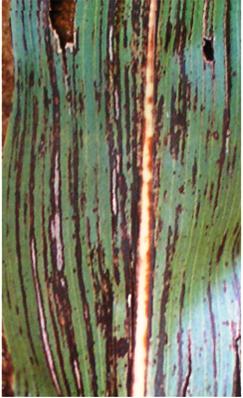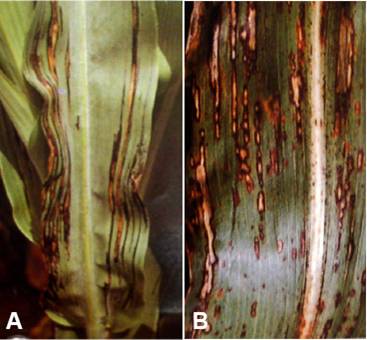CGKB News and events Stog-sorghum
Safe transfer of sorghum germplasm
Contributors to this page: ICRISAT, Patancheru, India (RP Thakur, AG Girish, VP Rao).
The Plant Quarantine Laboratory (This email address is being protected from spambots. You need JavaScript enabled to view it.) at ICRISAT, Patancheru, India caters to the plant quarantine requirements of the ICRISATscientific community with respect to the germplasm exchange of ICRISAT’s mandate crops: sorghum [Sorghum bicolor (L.) Moench)], pearl millet [Pennisetum glaucum (L.) R. Br.], chickpea [Cicer arietinum (L.)], pigeonpea [Cajanus cajan (L.) Millspaugh], groundnut [Arachis hypogaea (L.)] and six small millets: finger millet [Eleusine coracana (L.) Gaertn.], foxtail millet [Setaria italica (L.) Beauv.], little millet (Panicum sumatrense Roth.ex Roem. & Schult.), barnyard millet [Echinochloa crussgalli (L.) Beauv.], proso millet [Panicum miliaceum (L.)] and kodo millet [Paspalum scrobiculatum (L.)].
Indian plant quarantine regulations are legislated under the Destructive Insects and Pests Act, 1914 and the Plant Quarantine Order 2003 for the purpose of prohibiting and regulating the import of agricultural articles into India.
- Seed and plant material of these crops cannot be exported/ imported directly by the institute’s scientists.
- The National Bureau of Plant Genetic Resources (NBPGR) of the Indian Council of Agricultural Research (ICAR), New Delhi, is the plant quarantine authority responsible for ICRISAT’s germplasm exchange.
In 1985, NBPGR established a Regional Station at Rajendranagar, Hyderabad to implement the quarantine regulations in South India, to ensure safe movement of germplasm.
This page includes sections on:
- Import and export requirements.
- Technical guidelines for the safe movement of germplasm and detection of relevant pathogens and pests.
- Best practices in place at ICRISAT.
References and further reading
Ahmed KM, Ravinder Reddy Ch.1993. A Pictorial guide to the identification of seed borne fungi of sorghum, pearl millet, finger millet, chickpea, pigeonpea and groundnut. Information Bulletin No. 34. Patancheru, A.P. 502 324 India: International Crops Research Institute for the semi-Arid Tropics. 200 pp.
Chakrabarty SK, Anitha K, Girish AG, Sarath Babu B, Prasada Rao RDVJ, Varaprasad KS, Khetarpal RK, Thakur RP. 2005. Germplasm exchange and quarantine of ICRISAT mandate crops. Information Bulletin No. 69. Rajendranagar 500 030, Andhra Pradesh, India: National Bureau of Plant Genetic Resources; and Patancheru 502 324, Andhra Pradesh, India: International Crops Research Institute for the Semi Arid Tropics. 80pp.
Import/export of sorghum germplasm
Contributors to this page: ICRISAT, Patancheru, India (RP Thakur, AG Girish, VP Rao).
Exporting Germplasm
The ICRISAT-PQL, in conjunction with NBPGR Regional Station, Hyderabad, conducts seed health tests on germplasm prior to export. The following export guidelines are to be followed before submitting seed material This email address is being protected from spambots. You need JavaScript enabled to view it. for export.
Guidelines
- Pre-export inspection of seed multiplication fields by NBPGR quarantine officials for seedborne diseases at various growth stages of the crop to avoid their spread.
- Collection of seed from fully mature and healthy plants.
- Cleaning seed to remove insects, pathogen propagules (smut sori, ergot sclerotia, and nematode cysts), weed seed, crop debris, soil clods, stones, other foreign material, and small, shrunken, discolored and damaged seed.
- Submission of an on-line request for export of germplasm (form available at ICRISAT intranet under GT-Crop Improvement).
- Submission of untreated seed in fresh muslin bags or paper packets along with the four-point declaration certificate (available at This email address is being protected from spambots. You need JavaScript enabled to view it.) for quarantine processing.
- Submission of the phytosanitary requirements, such as import permit, non-commercial value certificate, additional declaration for seed borne pathogens and pests, and any other specific regulations/requirements.
Examples of seed export letters are given below:
- Seed export letter - air mail
- Seed export letter - courier
For more detailed information see the full text of the Plant Quarantine Guidelines and Procedures for Germplasm Exchange of ICRISAT Mandate Crops (ICRISAT, 2004).
Importing Germplasm
Seed and plant material for research can only be imported into India after obtaining an Import Permit (IP). As per Schedule X of the Plant Quarantine Order, 2003, Director, NBPGR is empowered to issue import permits for all kinds of import of plant germplasm for public/private sector institutions in the country. An IP is also required to import live insects, all fungi in pure cultures, soil, or clay for microbiological studies or physical and chemical analyses. For each of these items, authorities designated by the Government of India issue the import permit. The consignee should abide by the following import guidelines.
Guidelines
- Submission of on-line request for import (form available at ICRISAT intranet under GT-Crop Improvement) of seed/plant/plant products/ other material) to This email address is being protected from spambots. You need JavaScript enabled to view it..
- Submission of the import application by This email address is being protected from spambots. You need JavaScript enabled to view it. to the relevant import-issuing authority (see table below).
Competent authorities to issue various import permits
|
Type of imports |
Permit issuing authority |
|
Seeds and plants for sowing, |
Director, NBPGR, Pusa Campus, New Delhi 110 012. India
|
|
Live insects |
Plant Protection Adviser to the Government of India, Directorate of Plant Protection Quarantine and Storage N.H. IV, Faridabad, Haryana 121 001, India
|
* After getting clearance from the Department of Biotechnology (DBT),
Block 2, 7th floor, C.G.O. Complex, Lodi Road, New Delhi 110030
- This email address is being protected from spambots. You need JavaScript enabled to view it. provides the import permit to the consignee along with mailing labels, guidelines, and an advance notice form for onward transfer to the consignor.
- Advance notification of shipment by the consignor to the Director, NBPGR, New Delhi 110012, India with a copy to the Chief Plant Quarantine Officer, ICRISAT. (The consignor should use green-mailing labels bearing the address “Director, NBPGR, New Delhi 110 012”).
- Accompanied baggage import: Seed and plant material brought as accompanied baggage also requires an IP and PC. The international airports located at New Delhi, Chennai, Mumbai, and Kolkata are the points of entry for seed/plant samples brought into India as accompanied baggage. In such cases the seed samples should be handed over to the staff of the Plant Quarantine and Fumigation stations at the airport.
For more detailed information see the full text of the Plant Quarantine Guidelines and Procedures for Germplasm Exchange of ICRISAT Mandate Crops (ICRISAT, 2004).
References and further reading
International Crops Research Institute for the Semi-Arid Tropics (ICRISAT). 2004. Plant Quarantine Guidelines and Procedures for Germplasm Exchange of ICRISAT Mandate Crops. Indian Council of Agricultural Research, India; National Bureau of Plant Genetic Resources, India; International CropsResearch Institute for the Semi-Arid Tropics, India.
Guidelines for the safe transfer of sorghum germplasm
Contributors to this page: ICRISAT, Patancheru, India (RP Thakur, AG Girish, VP Rao).
Technical Guidelines for the Safe Transfer of Germplasm and the protection of CGIAR Germplasm Banks: ICRISAT
Pathogens of quarantine significance of sorghum
|
Bacteria
|
|
Burkholderia andropogoni
|
|
Xanthomonas vesicola pv.holcicola
|
|
Fungi
|
|
Periconia circinata
|
|
Peronosclerospora sorghi
|
|
Colletotrichum graminicola
|
|
Claviceps sorghi
|
|
Sporisorium sorghi
|
|
Cercospora sorghi
|
|
Exserohilum turcicum
|
|
Ascochyta sorghi
|
|
Insects
|
|
Corcyra cephalonica
|
|
Ephestia cautella
|
|
Oryzaephilus surinamensis
|
|
Plodia interpunctella
|
|
Rhizopertha dominica
|
|
Sitophilus oryzae
|
|
Sitotroga cerealella
|
|
Prostephanus truncatus
|
|
Tribolium castaneum
|
Bacteria - sorghum
Contributors to this page: ICRISAT, Patancheru, India (RP Thakur, AG Girish, VP Rao).
|
Contents: |
Bacterial leaf stripe or bacterial blight
|
Bacterial leaf stripe (Burkholderia andropogonis) |
Scientific name
Burkholderia andropogonis Smith.
Other scientific names
Pseudomonas andropogonis, Pseudomonas woodsii
Importance
High
Significance
In general, the disease is of minor importance on sorghum. Bacterial leaf stripe is considered to be a low to intermediate priority disease of sorghum in eastern Africa.
Symptoms
Initial symptoms are small (1 cm long), linear, intervenal lesions. Lesions on leaves and sheaths are purple, red, yellow or tan, depending on the host reaction. Under favorable conditions, lesions may exceed 20 cm in length and they usually coalesce along the width of the leaf. Water soaking of tissue adjacent to a lesion is usually not observed under field conditions. Bacterial exudates is usually observed from infected portions of the leaf under microscopic observation. Lesions may also occur on the kernel, peduncle, and rachis, and also in the pith of the stalk.
Hosts
Sorghum halepense (aleppo grass), Sorghum bicolor (sorghum), Sorghum sudanense (Sudan grass), Trifolium repens (white clover), Vicia sativa (common vetch). Bougainvillea sp, Ceratonia siliqua (locust bean), Cicer arietinum (chickpea), Dianthus caryophyllus (carnation), Gypsophila paniculata (babysbreath), Limonium sinuatum (sea pink), Trifolium pratense (purple clover), Trifolium subterraneum (subterranean clover), Tulipa (tulip), Vaccinium (blueberries) and Zea mays (maize).
Geographic distribution
Worldwide, not reported from India on sorghum
Biology and transmission
The bacterial cells are gram-negative rods, slightly curved with rounded ends, usually motile due to single flagellum per each cell.
The flagellum is sheathed.
The colonies of these bacteria are mostly smooth on the medium.
Plant debris is considered to be the primary over wintering source of B. andropogonis for bacterial stripe infection of sorghum (Tarr 1962).
Detection/indexing methods
- Pre export field Inspection.
Treatment/control
- No suitable treatment is available for eradication of this bacteria
Procedures followed at the centers in case of positive test
- At ICRISAT - So far not detected
References and further reading
Tarr SAJ. 1962. Diseases of Sorghum, Sudan Grass and Broom Corn. The Commonwealth Mycological Institute, Kew, Surrey, 298 pp.
Bacterial leaf streak or bacterial streak
|
Bacterial leaf streak (Xanthomonas vasicola pv. holcicola) of sorghum: |
Scientific name
Xanthomonas vasicola pv. holcicola Elliott.
Other scientific names
Bacterium holcicola, Phytomonas holcicola, Pseudomonas holcicola, Xanthomonas campestris pv. holcicola, Xanthomonas holcicola
Importance
Medium
Significance
Bacterial leaf streak is of minor importance.
Symptoms
First symptoms are narrow, water-soaked, transparent leaf streaks, 2-3 mm wide by 2-15 mm long, appearing as early as the second leaf stage of the seedling. Lesions soon turn red, become opaque, and at intervals may broaden into somewhat irregularly shaped oval spots with tan centers and narrow red margins. In severe attacks, these coalesce to form long irregular streaks and blotches extending across all or much of the leaf blade, with dead tissue bordered by narrow, dark margins between the reddish-brown streaks. Abundant bacterial exudates is produced as light-yellow droplets, which dry to thin white or cream scales (Williams et al. 1978).
Hosts
Panicum miliaceum (millet), Setaria italica (foxtail millet), Sorghum halepense (aleppo grass), Sorghum sudanense (sudan grass) and Sorghum bicolor (common sorghum)
Geographic distribution
Worldwide but not reported on sorghum from India
Biology and transmission
Soil borne and infected plant debris transmitted the bacteria. No evidence of seed borne bacteria for transmission.
Detection/indexing methods
- At ICRISAT: Pre export Field inspection
Treatment/control
- No seed treatment.
Procedures followed at the centers in case of positive test
- At ICRISAT - So far not detected.
References and further reading
Williams RJ, Frederiksen RA and Girard JC. 1978. Sorghum and Pearl Millet Disease Identification Handbook. Information Bulletin No. 2. ICRISAT, Patancheru 502 324, AP, India. 88pp.



 Stog-sorghum
Stog-sorghum


